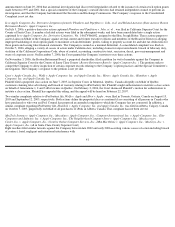Apple 2006 Annual Report Download - page 52
Download and view the complete annual report
Please find page 52 of the 2006 Apple annual report below. You can navigate through the pages in the report by either clicking on the pages listed below, or by using the keyword search tool below to find specific information within the annual report.
standards, including American Institute of Certified Public Accountants Statement of Position (“SOP”) No. 97-2, Software Revenue
Recognition
, as amended, and SEC Staff Accounting Bulletin (“SAB”) No. 104, Revenue Recognition.
The Company recognizes revenue when persuasive evidence of an arrangement exists, delivery has occurred, the sales price is fixed or
determinable, and collection is probable. Product is considered delivered to the customer once it has been shipped, and title and risk of loss
have been transferred. For most of the Company’s product sales, these criteria are met at the time the product is shipped. For online sales to
individuals, for some sales to education customers in the U.S., and for certain other sales, the Company defers revenue until the customer
receives the product because the Company retains a portion of the risk of loss on these sales during transit. If at the outset of an arrangement
the Company determines the arrangement fee is not, or is presumed not to be, fixed or determinable, revenue is deferred and subsequently
recognized as amounts become due and payable and all other criteria for revenue recognition have been met.
The Company records reductions to revenue for estimated commitments related to price protection and for customer incentive programs,
including reseller and end-user rebates, and other sales programs and volume-based incentives. For transactions involving price protection, the
Company recognizes revenue net of the estimated amount to be refunded, provided the refund amount can be reasonably and reliably estimated
and the other conditions for revenue recognition have been met. If refunds cannot be reliably estimated, revenue is not recognized until reliable
estimates can be made or the price protection lapses. For customer incentive programs, the estimated cost of these programs is recognized at the
later of the date at which the Company has sold the product or the date at which the program is offered. The Company also records reductions
to revenue for expected future product returns based on the Company’s historical experience. Future market conditions and product transitions
may require the Company to increase customer incentive programs and incur incremental price protection obligations that could result in
additional reductions to revenue at the time such programs are offered. Additionally, certain customer incentive programs require management
to estimate the number of customers who will actually redeem the incentive based on historical experience and the specific terms and
conditions of particular incentive programs. If a greater than estimated proportion of customers redeem such incentives, the Company would be
required to record additional reductions to revenue, which could have a material adverse impact on the Company’s results of operations.
Allowance for Doubtful Accounts
The Company distributes its products through third-
party distributors and resellers and directly to certain education, consumer, and commercial
customers. The Company generally does not require collateral from its customers; however, the Company will require collateral in certain
instances to limit credit risk. In addition, when possible, the Company does attempt to limit credit risk on trade receivables with credit
insurance for certain customers in Latin America, Europe, Asia, and Australia and by arranging with third-party financing companies to
provide flooring arrangements and other loan and lease programs to the Company’s direct customers. These credit-financing arrangements are
directly between the third-party financing company and the end customer. As such, the Company generally does not assume any recourse or
credit risk sharing related to any of these arrangements. However, considerable trade receivables that are not covered by collateral, third-party
flooring arrangements, or credit insurance are outstanding with the Company’s distribution and retail channel partners.
The allowance for doubtful accounts is based on management’s assessment of the collectibility of specific customer accounts and includes
consideration of the credit worthiness and financial condition of those specific customers. The Company records an allowance to reduce the
specific receivables to the amount that is reasonably believed to be collectible . The Company also records an allowance for all other trade
receivables based on multiple factors including historical experience with bad debts, the general economic
51
























